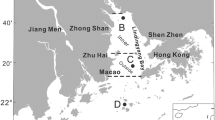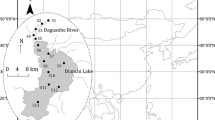Abstract
Although the long-term effects and the fate of petroleum hydrocarbons in marine and freshwater environments are not fully understood, it is generally recognized that much of the oil released by accidental spills or by various land sources ends up in the sediment where it may remain for at least several years The present study was undertaken to collect some initial data on the hydrocarbon concentrations in surficial sediments of lakes St Clair, Erie, and Ontario
The distribution of hydrocarbons in these lakes followed the general patterns found for a number of contaminants, in that the distribution tended to coincide with the outlines of the sedimentary basins The highest concentrations were found in the Western Basin of Lake Erie and in the inshore zone around the west end of the lake, suggesting major inputs from the Detroit River Apart from some spots of high concentration around known dumping grounds, the concentrations gradually diminish toward the east The distribution pattern in Lake Ontario may be more readily ascribed to water circulation patterns than to any specific source around the lake The hydrocarbon levels were found to be significantly lower than those in Lake Erie in Lake St Clair only trace quantities of hydrocarbons were found, suggesting either low inputs or low sedimentation/accumulation rates due to its shallowness
Although the present survey was limited to the top 3 cm of the sediments, the resulting distribution patterns indicate the western end of Lake Erie as the area with the heaviest hydrocarbon loadings The results may also facilitate the selection of specific areas where core sampling coupled with more complete analysis of the extracts could yield significant information on the long-term accumulation of anthropogenic hydrocarbons, and on their persistence and transformations in Great Lakes sediments
Similar content being viewed by others
References Cited
Elliott, J. J., R. A. Brown, and T. D. Searl, 1973, An infrared spectrophotometric method for measurement of hydrocarbons in ocean water: Anal. Chem., in press.
Farrington, J. W., and B. W. Tripp, 1977, Hydrocarbons in western North Atlantic surface sediments: Geochim. Cosmochim. Acta, v. 41, p. 1627–1641.
Hartung, R., and G. W. Klingler, 1968. Sedimentation of floating oils:Mich. Acad. Sci., Arts, Lett., v. 53, p. 23.
Hartung, R., and G. W. Klingler, 1970, Concentration of DDT by sedimented polluting oil: Environ. Sci. Tech., v. 4, p. 407–410.
Meyers, P. A., N. Takeuchi, and J. A. Robbins, 1980a, Petroleum hydrocarbons in sediments of Saginaw Bay, Lake Huron: J. Great Lakes Res., v. 6, no. 4, p. 315–320.
Meyers, P. A., S. J. Edwards, and B. Eadie, 1980b, Fatty acids and hydrocarbon content of settling sediments in Lake Michigan: J. Great Lakes Res., v. 6, no. 4, p. 331–337.
Nagy, E., B. F. Scott, and J. H. Hart, 1981, The fate of oil and dispersant mixtures in freshwater ecosystems: Environmental Protection Service Report EPS 4-EC-81-3.
Simard, R. G., I. Hasegawa, W. Bandaruk, and C. E. Headington, 1951, Infrared spectrophotometric determination of oils and phenols in water: Anal. Chem., v. 23, p. 1384.
Simmons, T. J., 1976. Continuous dynamical computations of water transports in Lake Erie for 1970: J. Fish. Res. Board Canad v. 33, p. 385–403.
Thomas, R. L., J. M. Jaquet, and A. Mudroch, 1975, Sedimentation processes and associated changes in surface sediment trace metal concentrations in Lake St. Clair, 1970–1974: Int. Conf Heavy Metals in the Environ., Toronto, p. 691–708.
Thomas, R. L., and A. Mudroch, 1979, Small craft harbours—Sediment survey, Lakes Ontario, Erie and Lake St. Clair. Dredging summary and protocol: Report to Small Craft Harbours Ontario Region from the Great Lakes Biolimnology Laboratory, December, 1979.
Vandermeulen, J. H., and D. C. Gordon, Jr., 1976, Re-entry of 5-year old stranded Bunker C fuel oil from a low energy beach into the water, sediments and biota of Chedabucto Bay, Nova Scotia. J. Fish Res. Board Canad., v. 33, p. 2002–2010.
Author information
Authors and Affiliations
Rights and permissions
About this article
Cite this article
Nagy, E., Mudroch, P., Mudroch, A. et al. Hydrocarbons in the surficial sediments of Lakes St. Clair, Erie, and Ontario. Environ. Geol. Water Sci 6, 31–37 (1984). https://doi.org/10.1007/BF02525567
Issue Date:
DOI: https://doi.org/10.1007/BF02525567




